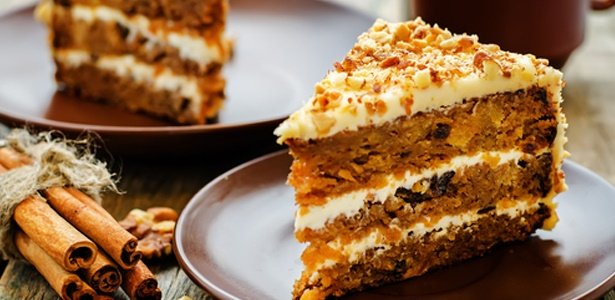The origin of carrot cake – as we know it, is somewhat obscured by history. What we do know is that bakers have been using carrots in baked goodies since medieval times and carrot cake made a bit of a resurgence in war times as a result of rationing and then went stratospheric in the 70s being rated as one of the top fad foods of that decade.
These days it remains ever popular, because it is moist, boasts one of the best icings around (cream cheese icing) and by some people’s reasoning, it is marginally healthier than other cakes because it contains at least one serving of vegetables!
Oil based cakes
Cakes can either be made with butter or oil. Oil-based cakes tend to be more moist than a butter cake because the oil is liquid at room temperature. Also, oil-based cakes stay fresh far longer than butter-based cakes. Bear in mind the oil does not contain any salt, so remember to add a pinch of salt (if not specified in the recipe). Use oils that do not have a strong flavour for example sunflower, canola or peanut oil and avoid those like olive oil that have a strong flavour.
A bit of cake chemistry
Most cake recipes call for some kind of raising agent. Baking powder is the most common and is a pre-mixed powder containing bicarbonate of soda and tartaric acid. When a base (like bicarb) and an acid (like tartaric acid) combine the result is carbon dioxide bubbles that cause the cake to rise. But some recipes, such as carrot cake, call for both bicarb and baking powder. In this case the bicarb helps the cake to rise along with the baking powder but it also darkens the colour of the cake. If left out, or replaced with baking powder it would be a much paler mixture.
Top tip: Bicarbonate of soda may also be referred to as baking soda.
Brown sugar
It seems that there is an overwhelming choice of brown sugars on the market these days. For the purposes of carrot cake pretty much any of them would do the trick, anything from the light brown sugar to the darkest treacle sugar. Use what you have on hand, but bear in mind that the darker treacle sugars will give a darker, moister cake and also contribute a flavour of their own to the final product.
A quick guide to South African brown sugars:
Light brown – refined sugar with a small quantity of residual molasses
Demerara or treacle sugar – unrefined sticky sugar enriched with treacle syrup
Muscovado– partially refined dark brown sugar enriched with molasses
Top tip: if your brown sugar has formed a clump, place a slice of bread in the container and leave overnight, it will be good as new in the morning
Measuring syrup
When it comes to measuring syrups, things can get into a sticky mess. Rub a light coating of oil onto the inside of the measuring cup or the bowl of your scale, and it should pour out easily without half of the syrup getting left behind.
Variations on the recipe
The great things about a simple recipe such as carrot cake is that it lends itself to variations.
Here are just a few ideas:
– Select any nuts that take your fancy the more exotic the better.
– Vary the spice ratios or substitute a spice mix such as 5-spice.
– Add in raisins or sultanas, or chopped tinned pineapples for a more fruity cake.
– Replace some of the grated carrot with another grated vegetable such as beetroot or sweet potato.
Making the icing
To make the icing snow white, replace the butter with a white margarine. Use the highest fat content cheese possible to prevent the mixture from becoming too runny when the sugar is added.
Storing your cake
Carrot cake can be stored in an air-tight container for about a week at room temperature or for 3-6 months in the freezer. Before freezing any cake, wrap it tightly in cling film to prevent dehydration of the cake. Any extra icing can also be stored in the freezer for up to 6 months.
For the ultimate carrot cake recipe, click here.

